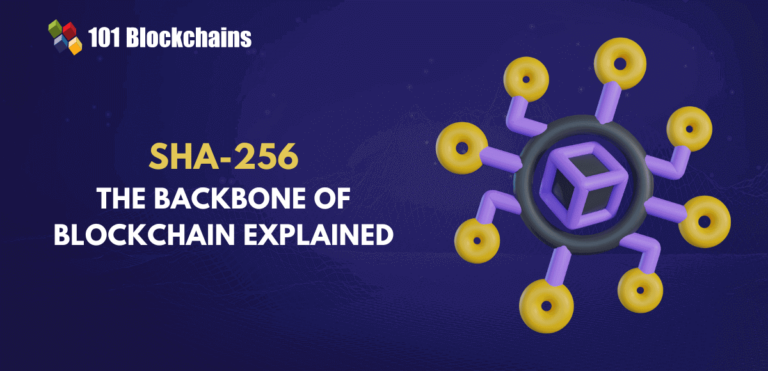Cryptography plays a vital role in strengthening the foundations of network security. The SHA-256 algorithm is one of the prominent examples of encryption algorithms that safeguard information in the digital world. Encryption and hashing are crucial processes for scrambling raw information to ensure that it cannot be reproduced in the original form. SHA-256 is a hashing algorithm that is used widely in many real-world applications. The SHA-256 encryption algorithm belongs to a family of cryptographic algorithms designed by the National Security Agency. Let us learn more about the most popular hashing algorithm and how it works.
Definition of the SHA-256 Algorithm
The terms “SHA” and “256” speak everything about the SHA-256 algorithm. SHA stands for Secure Hashing Algorithm and refers to a family of cryptographic functions designed for data security. The algorithms take raw data and turn it into a random string of characters. The “256” in SHA-256 indicates the fixed size of the random string of characters generated by the algorithm. Irrespective of the size of input data, the algorithm will always generate a 256-bit output.
The SHA-256 algorithm also ensures that minor changes in input data generate completely different hashes. The effectiveness of SHA-256 makes it an ideal pick for safeguarding sensitive information and verification of data integrity. It has emerged as a reliable successor to the SHA-1 family of encryption algorithms, which proved ineffective against brute force attacks.
Secret of the Effectiveness of SHA-256 Algorithm
The fundamental description of SHA-256 algorithm suggests that it might be difficult to understand how it works. You need to look at the individual steps in the working mechanism of SHA-256 to understand how it is effective at safeguarding sensitive data. The working of SHA 256 algorithm explained in simple terms describes how it takes raw input data, breaks it down and scrambles it to generate a string of characters. The output of the algorithm is a hash that represents a digital fingerprint of input data and ensures data integrity. You can learn more about how SHA-256 algorithm works with an overview of the following steps.
Preparing the Input
SHA 256 algorithm can take input data of any length and prepares raw data for processing in the first step. The preparation process involves addition of padding bits to the raw data to ensure that it can fit within fixed-sized chunks. The padding process also includes the addition of a bit that represents the original length of the input.
Initial Configuration
The algorithm then begins generating initial hash values as the starting point for the setup process. Initial hash values are pre-defined constants of the algorithm that are chosen from fractions of the square roots of first eight prime numbers.
Data Processing in Blocks
The answers to “How does SHA-256 algorithm work?” emphasize the data processing step as the scrambling begins in this step. SHA-256 splits the prepared data into 512-bit blocks that go through 64 rounds of processing operations. The 512-bit blocks are divided into 16 smaller blocks and then the algorithm expands the small blocks into 64 chunks by using a sequence of logical operations.
Deploying the Compression Function
Most of the heavy lifting in the workflow of SHA-256 algorithm goes on the shoulders of the compression function. It helps in processing the 512-bit blocks in 64 rounds. The algorithm leverages a blend of bitwise operations, bit shifts and modular addition in all the 64 rounds. The compression function mixes the data in a complex way so that small changes in the inputs can generate completely different outputs.
Final Hash Generation
The final step in the working of SHA-256 involves generation of final hash values after processing all blocks. The algorithm creates the final 256-bit hash by combining the hash values generated after compression. You can have a unique digital representation of the original input data in the final hash as a hexadecimal string.
Measuring the Level of Safety with SHA-256
The complex process involved in transforming input data into encrypted hashes shows that SHA-256 is a useful choice to ensure data security. Many people are likely to have concerns about SHA 256 algorithm steps and whether they can effectively safeguard sensitive information. It has been one of the most popular standards for security with the assurance of highly secure hashing. The US government also recommends SHA-256 as the ideal algorithm to ensure security of sensitive information across all agencies.
SHA-256 provides the assurance of data security with three properties. The first property is that it is practically impossible to reconstruct initial data from hash value. The next property of SHA-256 revolves around the minimal possibilities of a collision or two messages with same hash value. Another trait of SHA-256 is the assurance of generating new hash values from similar data in a way that no one can recognize the input data.
Build your identity as a certified blockchain expert with 101 Blockchains’ Blockchain Certifications designed to provide enhanced career prospects!
Discovering the Applications of SHA-256 Algorithm
You must have used the SHA-256 algorithm in digital communication and many other applications. The robust cryptographic properties, readiness for quantum computing attacks and resistance to common security attacks makes SHA-256 the first pick for various applications. Learn about the significance of SHA-256 algorithm with the following real-world applications.
Cryptocurrencies
The most popular SHA 256 algorithm example will be cryptocurrencies as the algorithm supports many critical functions in the Bitcoin blockchain. Cryptocurrencies use the algorithm to create unique identifiers for hashing transactions. It is a core component in cryptocurrencies that use the Proof of Work consensus mechanism for verification of transactions. The robust security of SHA-256 offers a reliable safeguard for cryptocurrencies against double spending and fraud.
Digital Signatures
SHA-256 is also the first choice for digital signatures to achieve integrity and authenticity of electronic documents. It helps in computing the hash for digital signature on a document which is encrypted with the private key of signer. Recipients of the digital signature can verify it by using the private key of the signer. You can also compare the resulting hash and the hash of the received document to verify digital signatures. SHA-256 is used in digital signatures for contracts and legal documents as well as for secure digital communication.
SSL/TSL Certificates
SSL/TCL certificates are crucial protocols for safeguarding digital communication over the internet. The fundamentals of SHA 256 algorithm explained the role of the algorithm in ensuring data authenticity. It is an important benefit for the applications of SHA-256 in generating SSL/TSL certificates. In simple words, SHA-256 ensures that you use a legitimate website with the assurance of encrypted data exchange between the website and your browser. The benefits of SHA-256 in internet communication primary revolve around preventing the risk of attacks by intermediaries and other security breaches.
Start learning Blockchain with World’s first Blockchain Career Paths with quality resources tailored by industry experts Now!
Future Direction of SHA-256 Algorithm
The most important aspect of discussions about SHA-256 algorithm focuses on the future of the algorithm. It is important to note that SHA-256 was introduced as a successor to previous algorithms that proved ineffective. The evolution of technology will create new challenges for network and data security thereby creating doubts regarding the future of SHA-256.
One of the notable examples of challenges for SHA-256 is the rise of quantum computing attacks. Quantum computer can solve complex mathematical problems in seconds and break conventional encryption algorithms such as SHA-256. The good news is that quantum computing attacks have not matured enough to breach SHA-256 algorithm. On top of it, researchers have been actively working on the development of quantum-resistant algorithms for preparing against technical advancements in quantum computing.
Researchers have also been continuously looking for vulnerabilities in SHA-256 through continuous analysis and research. The rigorous audit of SHA-256 sheds light on the assurance of security with the algorithm. The sustained adoption of SHA-256 encryption algorithm with integration into different systems provides the ideal foundation for its continued use in future. SHA-256 may have to evolve with new adaptations and combinations with other cryptographic techniques to achieve better security.
The most important requirement to safeguard the future of the SHA-256 algorithm is awareness. Security professionals, developers and the broader public must know about the importance of encryption algorithms. Promotion of best practices for implementing SHA-256 can help in bringing attention towards the advantages gained from its applications. It is also important to pay attention to the role of regulations for cryptographic practices in the use of SHA-256 algorithm. Future standards and regulations may add new practices that will affect the evolutionary changes in SHA-256.
Final Thoughts
SHA-256 is a powerful algorithm for encryption of sensitive data through a process involving complex steps. The algorithm processes raw data and breaks it down into 512-blocks which go through 64 rounds of bitwise operations and other complex processes to generate the final hash. Hashing helps in protecting sensitive information from exposure to intermediaries in digital communication. You can notice examples of SHA-256 applications in cryptocurrencies and digital signatures as well as your daily interactions with different websites. SHA-256 algorithm must go through continuous improvement to achieve robust levels of security for sensitive digital information. Learn more about fundamentals of encryption to discover new insights on effectiveness of SHA-256 algorithm.
*Disclaimer: The article should not be taken as, and is not intended to provide any investment advice. Claims made in this article do not constitute investment advice and should not be taken as such. 101 Blockchains shall not be responsible for any loss sustained by any person who relies on this article. Do your own research!




